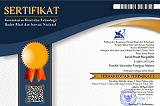Pembuatan Automatic Sterilizer Chamber Sebagai Upaya Pencegahan Penyebaran Pandemi Covid-19
Abstract
The disease caused by the Corona Virus (Covid-19) is a disease that is transmitted through small droplets that are produced when an infected person coughs, sneezes, or exhales. This droplet cannot stay in the air for a long time, so it quickly falls and sticks to the surface of the floor, hands, or others. Besides, it can be transmitted when someone touches the surface of a contaminated object and then touches the eyes, nose, or mouth. A series of government efforts were taken to minimize the spread of this virus, starting with policies to limit activities outside the home, restricting schools, working, and implementing large-scale regional quarantines, all of which were carried out to reduce the spread of Covid-19. Through the community service program carried out by lecturers and students in contributing to solving problems in society by making Automatic Sterilizer Chambers, the existence of this tool is able to help the local community in dealing with its spread, which can be seen from the good response given by the community or local officials. This was evidenced by the enthusiasm of the participants who came to use the tool either at the village hall, school, or in other public places.
Keywords
Full Text:
PDF (Bahasa Indonesia)References
Badan Pusat Statistik. (2019). Sumenep Dalam Angka 2019. Badan Pusat Statistik (BPS).
Hui, D. S., I Azhar, E., Madani, T. A., Ntoumi, F., Kock, R., Dar, O., Ippolito, G., Mchugh, T. D., Memish, Z. A., Drosten, C., Zumla, A., & Petersen, E. (2020). The continuing 2019-nCoV epidemic threat of novel coronaviruses to global health — The latest 2019 novel coronavirus outbreak in Wuhan, China. International Journal of Infectious Diseases. Vol 91 (3). 264–266 pp. https://doi.org/10.1016/j.ijid.2020.01.009
Mona, N. (2020). Konsep Isolasi Dalam Jaringan Sosial Untuk Meminimalisasi Efek Contagious (Kasus Penyebaran Virus Corona Di Indonesia). Jurnal Sosial Humaniora Terapan. Vol 2 (2), 117–125 pp.
Setiawan Rifqi, A. (2020). Lembar Kegiatan Literasi Saintik untuk Pembelajaran Jarak Jauh Topik Penyakit Coronavirus 2019 (COVID-19). Jurnal Ilmu Pendidikan. Vol 2 (1). 28–37 pp.
https://doi.org/https://doi.org/10.31004/edukatif.v2i1.80
Shi, Q., Dorling, D., Cao, G., & Liu, T. (2020). Changes in population movement make COVID-19 spread differently from SARS. Social Science & Medicine. Vol 255. https://doi.org/10.1016/j.socscimed.2020.113036
Widiyani, R. (2020). Latar Belakang Virus Corona, Perkembangan hingga Isu Terkini. DetikNews. https://news.detik.com/berita/d-4943950/latar-belakang-virus-corona-perkembangan-hingga-isu-terkini
World, & Organization, H. (2019). Coronavirus. World Health Organization. https://www.who.int/health-topics/coronavirus
Yunus, N. R., & Rezki, A. (2020). Kebijakan Pemberlakuan Lock Down Sebagai Antisipasi Penyebaran Corona Virus Covid-19. SALAM: Jurnal Sosial Dan Budaya Syar'i. Vol 7 (3). https://doi.org/10.15408/sjsbs.v7i3.15083
Zhu, H., Wei, L., & Niu, P. (2020). The novel coronavirus outbreak in Wuhan, China. Global Health Research and Policy. Vol 5 (6). https://doi.org/10.1186/s41256-020-00135-6
DOI: https://doi.org/10.21107/pangabdhi.v7i1.8654
Refbacks
- There are currently no refbacks.
Copyright (c) 2021 doni abdul fatah

This work is licensed under a Creative Commons Attribution-ShareAlike 4.0 International License.
Jurnal Ilmiah Pangabdhi by Universitas Trunojoyo Madura is licensed under a Creative Commons Attribution-ShareAlike 4.0 International License.













